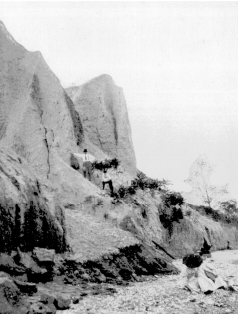III. Overview
The site plan for Fort Sheridan grew out of its unique location high on the bluffs of Lake Michigan in an area cut by deep ravines. Its history is intimately tied to Chicago’s, for without the labor unrest of the 1870s and 1880s, the Fort would not have been built. Architecturally, the Fort is a masterpiece, linked to two of Chicago’s most influential designers -- the architectural firm of Holabird & Roche and the landscape architect Ossian C. Simonds.

Scene near Fort Sheridan, Bluffs along
Lake Michigan
Susan S. Banjamin Postcard Collection
III. Geological History
Fort Sheridan is located on the Highland Park glacial moraine, also known as the Valparaiso glacial moraine, formed by retreating glaciers. The area was heavily forested and very fertile. It initially was drained by six streams flowing eastward through deep ravines, filled with native flora and fauna, into Lake Michigan. The glaciers, wind, and waves that formed the lakefront carved out the ravines. Today they are named Hutchinson, Wells, Bartlett, Van Horne, Shenck, and Janes Ravines after men associated with the Fort’s history.
Send any Fort-related news update information to mrtollfree@aol.com

